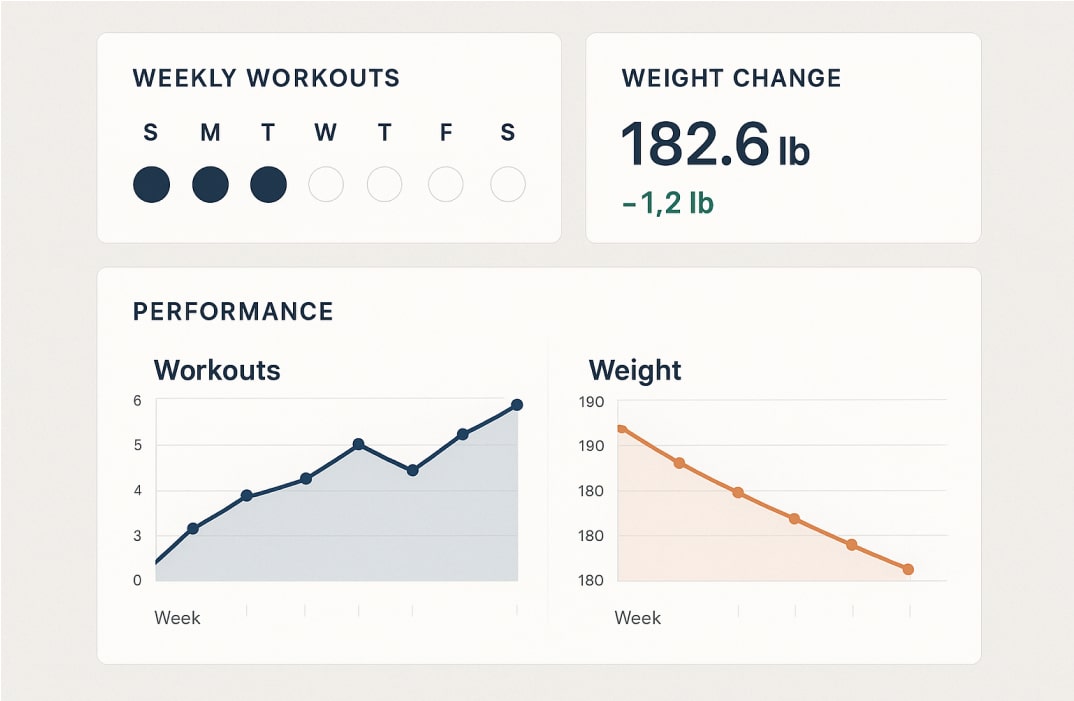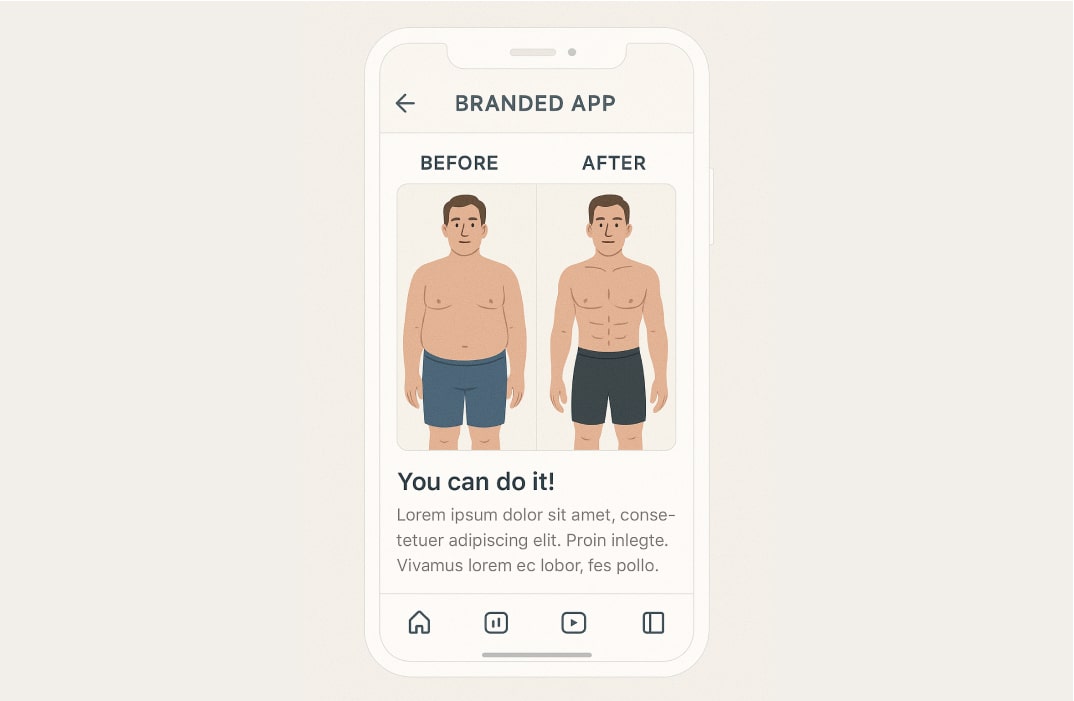Are You Earning Up to Your Potential?
Most personal trainers are undervaluing their time and skills. Our Personal trainer Revenue Calculator helps you find out what you should be making, and how to get there.
No guesswork. Just real numbers.
.jpg)
Most personal trainers think growth comes from signing more clients. But here’s the truth–if you can’t keep the clients you already have, you’ll always be stuck in a cycle of chasing leads and replacing dropouts.
Client retention is the real challenge in the personal training industry. It’s not just about keeping people paying for training sessions. It’s about maintaining relationships, keeping clients engaged, and guiding them through their fitness journey long term.
In this blog, you’ll learn about 15 actionable strategies on how to retain online fitness clients. Whether you’re offering online personal training, hybrid coaching, or in-person sessions with a digital component, these tactics will help you build lasting relationships, improve client satisfaction, and grow a thriving fitness business.
Also read: How to Get Clients as a Personal Trainer: 15 Proven Ways
Why Retention Is the Real Growth Driver for Fitness Coaches
Many personal trainers focus most of their energy on client acquisition. They run ads, post endlessly on social media, and push for new sign-ups. While this brings in potential clients, the truth is that growth doesn’t come from adding more names to your roster. It comes from keeping the ones you already have.
Studies across the fitness industry show that retaining clients is 5x more cost-effective than acquiring new ones. That means every time a client leaves, you’re not just losing a monthly payment—you’re also losing the time, money, and effort you spent to bring them in.
{{gyms-bio-form-v2="/blog-bio-comp-v2"}}
Retaining Clients vs. Chasing New Business
New clients are exciting, but they’re also unpredictable. They need more education, onboarding, and encouragement just to stay on track. On the other hand, existing clients already know your style, trust your coaching, and have begun their fitness journey with you. Retaining them requires less work but creates more stability.
A strong client retention strategy for fitness coaches ensures predictable revenue, steadier cash flow, and deeper client relationships. Instead of worrying about where the next client will come from, you can focus on improving your programs and scaling your business.

88% trainers worldwide gave us 5 stars
Transform your fitness business with the power of your branded app on iOS and Android.
Try for FREEThe Hidden Cost of Client Churn in Online Personal Training
When a client leaves, the loss goes beyond one missed payment. Client churn disrupts your momentum, hurts your confidence, and can damage your reputation if too many clients slip away. In the world of online personal training, where relationships rely heavily on communication and engagement, the risk is even higher.
If your clients aren’t engaged, don’t see progress, or feel disconnected, they’ll move on quickly—sometimes within weeks. That’s why personal trainer client retention must be your top priority. A loyal client not only stays longer but also refers friends, engages in challenges, and becomes a long-term advocate for your brand.
Bottom line: In the personal training industry, retention isn’t just important—it’s the key to building a thriving fitness business.
Let’s dive into 15 proven strategies that will help you keep online personal training clients long term.
1. Build a Strong Client-Trainer Relationship

At the heart of client retention is a strong relationship. Personal training isn’t just about sets and reps—it’s about trust, accountability, and human connection.
When clients feel you genuinely care about their fitness journey, they are far more likely to stay committed. That means celebrating their wins, listening to their struggles, and showing empathy when life gets in the way.
A strong client-trainer relationship also fosters mutual respect, which transforms training sessions into something clients eagerly anticipate—not just another appointment on their calendar. This bond is one of the most powerful retention tools in the entire fitness industry.
Pro Tip: Use regular check-ins (weekly or bi-weekly) to ask how clients are feeling outside of workouts. This shows you see them as people, not just personal training clients, which builds loyalty.
2. Set Clear Client Expectations Early
Many clients leave online personal training not because the workouts were bad, but because expectations were unclear. If a client thought they’d lose 20 pounds in two weeks and didn’t, frustration sets in quickly.
As a fitness professional, you need to establish clear client expectations from the very beginning. During onboarding, outline what progress looks like, how often you’ll check in, and what they’ll need to commit to. This creates alignment and avoids disappointment.
When clients know what to expect, they’re more likely to stay engaged—and less likely to slip away when results take time.
Pro Tip: Send a “Welcome Pack” or onboarding guide that explains your training programs, communication style, and timelines for progress.
3. Personalize Every Training Plan
Generic training plans are one of the fastest ways to lose clients. If a client feels like they’re following the same routine as everyone else, they’ll question the value of working with you.
Instead, create personalized training plans that fit their lifestyle, fitness goals, and current abilities. This doesn’t mean reinventing the wheel for every client—you can build templates and adapt them—but it should feel unique to the client.
Personalization shows clients that you’ve taken the time to understand their needs. It also makes them more invested in the process, which directly improves personal trainer client retention.
Pro Tip: Use progress tracking tools inside your own app to adjust training plans in real time. Small tweaks based on feedback can keep clients engaged and committed long term.
4. Track Clients’ Progress and Share Wins

One of the biggest reasons clients leave is because they don’t feel like they’re making progress. That’s why progress tracking is one of the most powerful retention tools in online personal training.
When you show clients measurable results they’re more motivated to keep going. Celebrating even small wins builds momentum and makes the fitness journey more enjoyable.
Pro Tip: Share weekly or monthly progress reports, complete with charts or photos, so clients can see how far they’ve come.
5. Keep Clients Engaged Between Sessions
Many trainers lose clients in the “in-between” time—the days when clients aren’t in a personal training session. If you don’t stay connected, clients can lose motivation quickly.
Engagement outside of workouts keeps clients accountable. Simple actions like sending check-in messages, sharing daily tips, or running quick challenges can help keep the momentum alive.
Pro Tip: Schedule automated reminders and motivational notes through your app to keep clients engaged even when you’re not online.
6. Build a Supportive Community
A supportive community transforms your business from a simple service into a lifestyle experience. Clients who feel connected to others are more likely to stay long term.
You can build community through private social media groups, messaging channels, or—better yet—a dedicated space in your own app. Encouraging clients to share wins, ask questions, and support one another builds accountability and belonging.
Pro Tip: Run monthly community fitness challenges to keep the group energy high and strengthen relationships.
7. Educate Clients Beyond Workouts

If you only provide workouts, clients may eventually wonder what else they’re paying for. Adding educational resources builds extra value and keeps clients invested in your coaching.
Nutrition advice, recovery tips, and lifestyle strategies help clients stay on track and make healthier choices outside the gym. This not only improves results but also strengthens the client-trainer relationship.
Pro Tip: Share weekly “quick tips” or short educational videos to reinforce your role as both a trainer and a trusted advisor.
8. Deliver Excellent Customer Service
Fitness may be your expertise, but customer service is what makes or breaks client retention. Clients who feel ignored or unsupported are likely to leave—even if your training programs are good.
Quick responses, proactive communication, and empathy go a long way in building satisfied clients. Excellent customer service shows you care about more than just payments—you care about the whole client experience.
Pro Tip: Set clear response time standards (like replying within 24 hours) to manage expectations and build trust.
9. Use Personalized Communication
Nothing kills engagement faster than generic, copy-paste messages. Clients want to feel like you’re speaking directly to them.
Using personalized communication, such as addressing them by name, referencing their specific goals, and acknowledging progress. This helps deepen the connection. When clients feel seen, they’re far more likely to stay loyal.
Pro Tip: Keep notes on each client’s personal life, milestones, or struggles, and reference them in your messages to show you truly care.
10. Encourage Clients During Low Motivation Periods
Every client will hit rough patches. Busy schedules, stress, or slow results can lead to frustration and dropouts.
As a fitness coach, your job is to step in with encouragement. Remind clients of their progress, reset small achievable goals, and reframe setbacks as part of the process. A supportive nudge during a low-motivation period can be the difference between losing a client or keeping them long term.
Pro Tip: Have a library of motivational messages or video pep talks ready to send when a client starts slipping.
11. Share Client Success Stories

Nothing inspires clients more than real-life examples. Sharing success stories shows proof that your training works and keeps both current and potential clients motivated.
Highlighting client transformations on social media, inside your app, or on your professional website also builds a positive brand image. This not only retains current clients but also attracts more clients through referrals.
Pro Tip: Ask clients for permission to feature their stories and progress photos—they’ll often feel proud to be showcased.
12. Offer Hybrid Training Options
Not every client wants purely online personal training. Some prefer the flexibility of blending in-person sessions with virtual coaching.
Offering hybrid training lets you meet clients where they are. This flexibility creates cost-effectiveness for you and convenience for them, reducing the chance they’ll leave due to scheduling or lifestyle changes.
Pro Tip: Let clients switch easily between online and in-person sessions without friction. Flexibility is a major driver of client retention.
13. Create Fitness Challenges to Boost Engagement
Gamification is one of the most fun and effective ways to keep clients engaged. Fitness challenges turn workouts into a shared goal, building excitement and community.
Challenges can be based on consistency, progress, or milestones (like steps, reps, or streaks). They create friendly competition and give clients something new to look forward to.
Pro Tip: Use your branded app to host challenges and track leaderboards—it keeps everything centralized and professional.
14. Collect Client Feedback—and Act on It
Clients want to feel heard. Regularly asking for client feedback shows that you care about their experience and are committed to improving.
But the real key isn’t just collecting feedback—it’s acting on it. When clients see their suggestions implemented, they feel valued and respected, which strengthens loyalty.
Pro Tip: Send quarterly surveys and share the changes you made based on responses. Transparency builds long-term trust.
15. Launch Your Own Branded App
If you want the ultimate client retention strategy for fitness coaches, a branded app is it.
An app centralizes everything—training plans, progress tracking, communication, nutrition, and community—in one professional space. It removes friction, builds your brand image, and gives clients a reason to stay long term.
Clients appreciate the convenience, and you gain a powerful retention tool that keeps your business scalable.
Pro Tip: Use FitBudd to launch your own app quickly without tech headaches—coaches using apps retain far more clients compared to spreadsheets or scattered platforms.
Conclusion
At the end of the day, client retention is the true growth engine of the personal training industry. New clients will always matter, but it’s the ones who stay with you long term that create stability, recurring revenue, and lasting impact.
By applying these 15 strategies—personalized training plans, strong client-trainer relationships, supportive communities, and consistent engagement—you’ll keep clients satisfied, motivated, and loyal. And with loyalty comes referrals, more clients, and a stronger reputation in the fitness industry.
Remember: a thriving fitness business isn’t built on one-time sign-ups. It’s built on lasting relationships and ongoing commitment. When you focus on client satisfaction, celebrate progress, and deliver excellent customer service, your clients won’t just stay—they’ll become your biggest advocates.
👉 Ready to see how top fitness coaches retain more clients with less effort? Book a free demo with FitBudd and discover how your own branded app can transform your retention strategy and set your business up for long-term success.
Frequently Asked Questions
How long do personal trainers usually keep clients?
Most personal trainers keep clients for about 6–12 months, but with a strong client retention strategy, many can extend that to multiple years. The key is keeping clients engaged with personalized training plans, ongoing support, and progress tracking.
What is a good client retention rate for a personal trainer?
A good retention rate for personal trainers is around 70–80%. Anything higher means you’re doing an excellent job at keeping online personal training clients long term. Lower rates often point to gaps in engagement, communication, or client satisfaction.
How can fitness coaches get more online clients?
Fitness coaches can get more clients online by showcasing success stories, offering valuable educational content, and building a strong presence on social media. Tools like your own branded app also make it easier to convert leads into long-term clients by offering a professional, seamless experience.
How do you maximize client retention?
To maximize client retention, focus on personalized communication, progress tracking, and building a supportive community. Clients stay longer when they feel valued, see results, and enjoy a strong client-trainer relationship.
Frequently Asked Questions

Ultimate Marketing Guide for Fitness Trainers
Boost your business growth with these tried and tested marketing strategies. Free for you to download.
Download Now
Templates
These functional templates have the power to make any fitness trainer's life easier.
Subscribe To
Our Blog


























